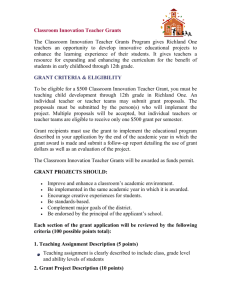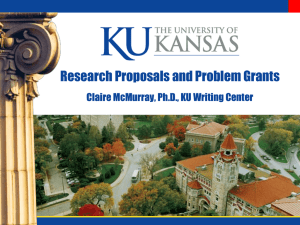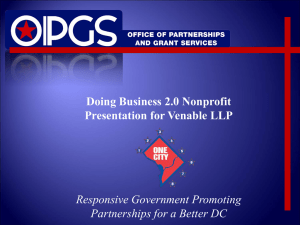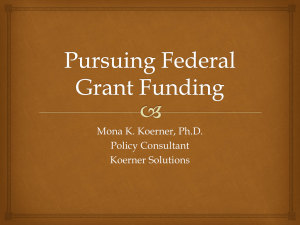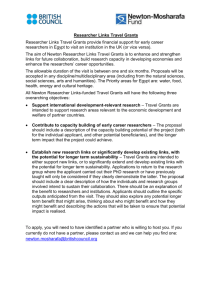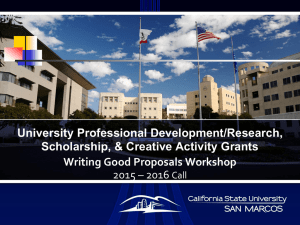Microsoft Word 2007
advertisement
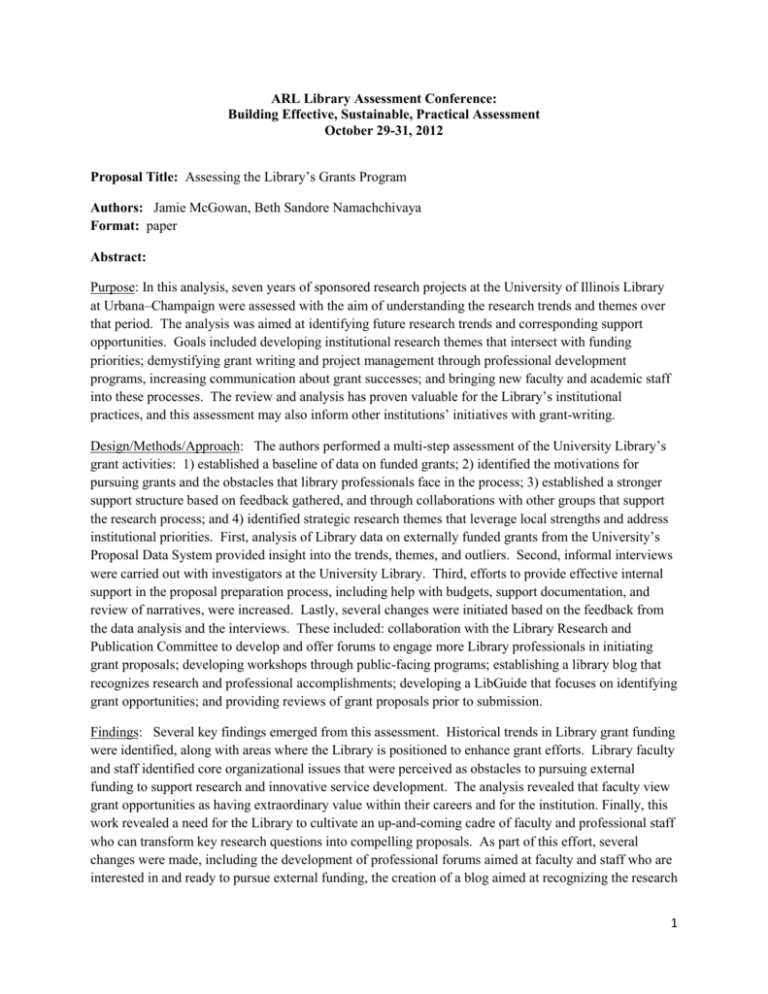
ARL Library Assessment Conference: Building Effective, Sustainable, Practical Assessment October 29-31, 2012 Proposal Title: Assessing the Library’s Grants Program Authors: Jamie McGowan, Beth Sandore Namachchivaya Format: paper Abstract: Purpose: In this analysis, seven years of sponsored research projects at the University of Illinois Library at Urbana–Champaign were assessed with the aim of understanding the research trends and themes over that period. The analysis was aimed at identifying future research trends and corresponding support opportunities. Goals included developing institutional research themes that intersect with funding priorities; demystifying grant writing and project management through professional development programs, increasing communication about grant successes; and bringing new faculty and academic staff into these processes. The review and analysis has proven valuable for the Library’s institutional practices, and this assessment may also inform other institutions’ initiatives with grant-writing. Design/Methods/Approach: The authors performed a multi-step assessment of the University Library’s grant activities: 1) established a baseline of data on funded grants; 2) identified the motivations for pursuing grants and the obstacles that library professionals face in the process; 3) established a stronger support structure based on feedback gathered, and through collaborations with other groups that support the research process; and 4) identified strategic research themes that leverage local strengths and address institutional priorities. First, analysis of Library data on externally funded grants from the University’s Proposal Data System provided insight into the trends, themes, and outliers. Second, informal interviews were carried out with investigators at the University Library. Third, efforts to provide effective internal support in the proposal preparation process, including help with budgets, support documentation, and review of narratives, were increased. Lastly, several changes were initiated based on the feedback from the data analysis and the interviews. These included: collaboration with the Library Research and Publication Committee to develop and offer forums to engage more Library professionals in initiating grant proposals; developing workshops through public-facing programs; establishing a library blog that recognizes research and professional accomplishments; developing a LibGuide that focuses on identifying grant opportunities; and providing reviews of grant proposals prior to submission. Findings: Several key findings emerged from this assessment. Historical trends in Library grant funding were identified, along with areas where the Library is positioned to enhance grant efforts. Library faculty and staff identified core organizational issues that were perceived as obstacles to pursuing external funding to support research and innovative service development. The analysis revealed that faculty view grant opportunities as having extraordinary value within their careers and for the institution. Finally, this work revealed a need for the Library to cultivate an up-and-coming cadre of faculty and professional staff who can transform key research questions into compelling proposals. As part of this effort, several changes were made, including the development of professional forums aimed at faculty and staff who are interested in and ready to pursue external funding, the creation of a blog aimed at recognizing the research 1 accomplishments of library professionals, and the institution of more frequent and consistent communication about grant and research opportunities. Practical Implications/Value: As a focused case study this can serve as a model to other academic and research libraries interested in two areas: 1) utilizing quantitative methods to understand and track the past and current trends related to research interests and grant funding and 2) using quantitative and qualitative data to design support systems for those in the Library seeking grants. Biographical Statements: Jamie McGowan is the International Program Manager at the Committee on Institutional Cooperation. She worked with the University of Illinois Library for a year, providing foundation, grants and community research support and is pursuing an M.S. in library and information science. She also has written many successful internal and external grants. Beth Sandore Namachchivaya is associate university librarian for research and technology, associate dean of libraries, and professor at the University of Illinois Library at Urbana-Champaign. She leads library programs in the areas of digital libraries, e-Research, and innovation. Her research focuses on the evaluation of digital libraries, and digital preservation programs, organizational change, and innovation. INTRODUCTION For over a decade the University of Illinois Library at Urbana-Champaign has sustained a track record of successful external grant funding. Grants support many types of activities, including research by librarians in library and information science and other fields, collection acquisition and processing, preservation, new user service programs, digitization, digital library development, assessment and evaluation, and professional development and training programs. In difficult economic times, libraries rely increasingly on grants to fund innovation and research. The impetus for this assessment study stems from the Library’s desire to identify ways to support librarians and staff who were successful at garnering grant funds, and to provide incentives and an ongoing support infrastructure that would encourage more librarians and staff to seek grants and to understand the drivers of success. This paper describes an analysis of the grants “landscape” in the Library and the resulting data helped the Library identify to better support librarians and other professionals to develop successful grants. In conducting this work, we sought answers to several core questions: What are the recent funding trends for the University Library? What can the University Library do to encourage success and minimize obstacles to grant submission? What can the institution do to support success after the award? 2 In what strategic areas could the Library expand its grant activities? UNDERSTANDING THE CONTEXT In today’s challenging economic climate, faculty and researchers are both motivated and expected to pursue external funding as a means of developing and sustaining institutional research and service functions. University libraries are no exception, with librarians seeking funding to support a variety of innovative new programs and to perform research.1 Given these professional and economic drivers, libraries are positioned either to initiate or to be partners in grants and sponsored research. Beyond a climate in which grant funding is good for the institution, grants support a number of the University of Illinois Library’s innovations. Grant funds incubate initiatives that extend the library’s core activities, projects and programs, and this infusion of support is critical to their success. In deciding to conduct a baseline evaluation, we are also mindful of the value of assessment to our organization and processes. Extending a “culture of assessment” to grant funding is a signal of its importance in the broader scope of library work.2 At the organizational level, this initial assessment also signals a commitment within the institution and among its leadership to prioritize external funding for evaluation. While it appears that libraries seek grants increasingly to support programs, services and research, the literature revealed scant analysis of grant funding programs in libraries. The average number of grants and level of grant funding at the University of Illinois Library has risen steadily over the past decade. This trend suggested that grant funding is evolving into a mainstream program area for libraries, which, like other library programs, should clearly be subject to assessment. As Lakos and Phipps reiterate, “what gets measured gets managed.” Quantitative and qualitative measures enable organizations to better support, individuals to increase their grant-writing success, and libraries to their infrastructure and culture of institutional research support. Three common themes emerged from the literature on grant–writing and librarianship. First, there are works that are more or less instructional, guiding one through the steps of writing a grant proposal.3 A second grouping outlines potential sources of funding.4 The third highlights the value of grants for career development.5 A 2004 ARL SPEC Kit survey on grant coordination reported that of 65 respondents, 62 libraries indicated that they pursued grants. Roughly half of those 65 libraries reported an increase in grant funding within the previous five-year period, and 40% reported that they had no change, and 10% reported a decrease in grant funding. Further, nearly two thirds of the libraries reporting vested the responsibility for managing grants in the librarians who were the grant’s principal investigator (PI) 6 To this scholarship we introduce a new thread, assessment of grant programs. The data analyzed were drawn from a University database that tracks grant proposal information, and from interviews conducted 3 with a librarians and professional staff who are actively engaged in grants that support research and service programs. The University’s Division of Management Information supports a Proposal Data System, providing current and historic proposal data dating back to 1996. Using this database, we accessed the University Library’s proposal data to provide the primary quantitative data. The data maintained by this database are sponsored research processed by the Office of Sponsored Programs and Research Administration, and they only represent grants submitted to external entities rather than institutionally based competitions. The database includes information about the status of grant proposals (awarded, declined and pending), the principal investigators names and affiliations, the title of the proposals, the funder, and the amount of money proposed, awarded, and spent, and the length of the awards. We initially sought to represent ten years of grant-writing. However, the accuracy of the proposal database deteriorated with legacy data from a system migration that occurred eight years ago. Hence, we focused on seven years of data, presented here. In analyzing these data, we opted to focus mostly on successful proposals, mapping between the award data, the Library as an organization, and more nuanced data about each proposal’s focus or intent. The second source of data was informal interviews with ten library faculty who have and/or are actively writing external grant proposals. The informational interviews offered rich qualitative data that added depth to our quantitative assessment. For instance, interviewees highlighted the professional and institutional value of grants, the context in which such grants emerge, and suggested avenues for improving the grant-writing process. Combined proposal data and interviews provide insights that guide institutional practices -- such that the University Library is better placed to develop strategic research initiatives, support initiatives underway, and cultivate grant-writing interests and skills across the library. We present a summary of the quantitative data next followed by the qualitative data. Following our analysis, we outline our responses to these findings. Again, one of our core goals is to support the development and success of grant-funded initiatives. These steps, assessments, and our initial responses are described in greater detail below. DEVELOPING A CASE STUDY: UNIVERSITY OF ILLINOIS LIBRARY GRANTS ANALYSIS The Big Picture: At the summary level, librarians and other professional staff in the University of Illinois Library submitted 146 grant proposals during the past 7 years. Eighty-five of these grants were awarded, yielding a success rate of 58.2%. The Library’s track record of garnering external funding compares favorably with the University of Illinois campus, which sustained a 48.4% success rate during the same period. For 4 the Library, new proposal success fluctuated from year to year (Figure 1). However, when multi-year grants are factored in, the distribution of grants levels out by comparison (Figure 2). Number of Grants Awarded, 2004-2011 Number of grants 25 20 15 10 5 0 2004 2005 2006 2007 2008 2009 2010 2011 Figure 1 Grants reflecting multi-year funding, 2004-2011 25 Number of grants 20 15 10 5 0 2004 2005 2006 2007 2008 2009 2010 2011 Figure 2 On the whole, funding represents a well-balanced blend of sources with the largest number of grants coming from associations (e.g., membership organizations such as the Digital Library Federation (DLF), and the Council on Library and Information Resources (CLIR); and professional associations such as the American Library Association (ALA), followed by federal agencies, philanthropic foundations, the State of Illinois, and other lesser sources. 5 Number of Awarded Grants by Sponsor, 2004-11 Foreign-Comm & Govt Special Contracts 7% 2% N=85 Federal 24% Philanthropic Fdns 19% IL-Secretary of State 14% Associations 31% Local Illinois Govt 3% Figure 3 In contrast, looking at the breakdown of actual funding dollars, foundations and federal monies accounted for the vast majority of the grant monies generated (Figure 4). Associations, such as the ALA, DLF, CRL, LAMA, and the State of Illinois offered many smaller grants that totaled 4% of the total amount. Special contracts, funding mostly archival initiatives, accounted for a 7% portion of the total. Grant Award Amounts by Sponsor, 2004-11 Foreign-Comm & Govt 0% Special Contracts 7% Total=$10,169,069 Federal 42% Philanthropic Fdns 43% Associations 4% IL-Secretary of State 4% Local Illinois Govt 0% Figure 4 To get a sense of faculty participation in grant-funded initiatives, we looked at the number of people serving as principal investigators or co-principal investigators on grants. Figure 5 represents these figures for the seven year period. On an annual basis, approximately 10% of librarians and professional staff serve as either a PI or CO-PI on grants; however, over time, grant awards go to approximately 30% 6 of the total library professional staff. The data indicated that a small and slowly growing number of librarians were repeatedly successful at getting grants. PIs and Co-PIs on Grants, 2004-2011 (42 PIs and 13 Co-PIs on 84 Grants) 30 Number of People 25 20 PI 15 Co-PI 10 5 0 1 2 3 4 5 Number of Grants 6 7 Figure 5 Strategic Agendas of both the Library and the Funders Through this analysis, we also sought to understand how funder’s strategic agendas influenced our choice of grant programs, and how Illinois’ institutional strengths could be heightened by identifying programs that were consonant with the Library’s and the institution’s strengths. To assess grant focus, we broke down the grants awards into several key categories of interest detailed in in Figure 6. Research 0% Funding Amounts by Grant Categories, 2004-11 Planning, Outreach, Assessment 2% Collection Development 1% Professional Development & Training 33% Access, Management, Preservation 57% Special Contracts 7% Figure 6 7 A further division of the Access, Management and Preservation data suggests that there was fairly equal interest in technology development, digitization and microfilming, and access, management, and preservation. (Figure 7) The professional development and training monies are largely used to support the University Library’s Mortenson Center for International Libraries Programs, which provides training to librarians globally. Access, Management, Preservation Grants: Funding by Sub-Categories, 2004-11 Total: $ 5,765,263 Technology Development 39% Planning & Equipment 1% Access, Management, Preservation 31% Digitization & Microfilming 29% Figure 7 To assess funding levels over time, we also compared average funding by year. The following graph represents average funding levels over time, divided up by the grant focus (Figure 8). Average Funding Levels from 2004-2011 250000.00 Access, Management, Preservation 200000.00 Collection Development 150000.00 Planning, Outreach, Assessment 100000.00 Professional Development and Training 50000.00 0.00 2004 2005 2006 2007 2008 2009 2010 2011 2012 Figure 8 8 These results illustrate the lower levels of funding for collection development as compared to access, management, and preservation or professional development and training. The external statesponsored collection acquisition grants dwindled to nil by 2009, which reflects the reduction of funds from the LSTA (Library Services and Technology Act) federal funding that is allocated to states. Also the dip in funding in 2010 is striking in most areas of funding. This dip can signal multiple changes. First, internally, several major grant initiatives ended in 2009. This meant that faculty were actively engaged in wrapping up their commitments to projects in 2009, and they were less involved in writing and submitting new project proposals. Second, the global economic crises also led to increased competition for funds, and University of Illinois Library was one of many institutions competing for reduced federal and foundation dollars. Library grant awards were smaller and the number of awards was also reduced. Over the past three years, the University Library faculty was awarded upwards of ten grant proposals; whereas in 2010, five proposals were funded. Last, the number of grant competitions and the size of awards may have also been impacted by the economic crises, as funders had to react to the crises. Equally striking is the bounce-back in average funding in 2011, where the level exceeds previous levels in three of the four categories. The number of grants funded in 2011 was even lower still with only three proposals being awarded funding. The rebound in funding levels was due to a number of continuing grants, as well as an award in 2011 of one substantial grant. None of the Library’s grants awarded during this time were derived from federal stimulus funds. In addition to comparing grant foci and funding over time, we did a similar assessment, where once again, time was the independent variable and funding amounts was the dependent variable (Figure 9). The analysis revealed that higher funding levels came from federal agency and philanthropic sources. Also, state sources of funding were on the increase but have disappeared as have associations’ funding support. It appears from these data that philanthropic foundations funded grants at consistently lower levels throughout the past few years of the economic downturn, but funding levels have increased in the past two years, with private foundations providing the Library’s highest average funding. Also, federal funding fell sharply in 2009 and 2010, and it has in recent years been on the increase. Certainly, the funding levels do not reflect funding sources alone. Grants coming to a close, application success rates, and levels of funding are primary contributors to funding fluctuations. The variables that lead to these conditions may be internal to the institutions, the competition, or the broader economic crises that led to a contraction of funding opportunities. 9 Average Funding levels by Source, 2004-2011 250000 200000 Associations 150000 Federal Philanthropic 100000 State of Illinois 50000 0 2004 2005 2006 2007 2008 2009 2010 2011 2012 Figure 9 Feedback from Interviews: The baseline assessment also incorporated qualitative data obtained from informal interviews conducted with ten librarians and one academic professional at the University Library to learn more about their perceptions of library grant-writing, the support provided, and processes. All of these individuals had participated in externally-sponsored grant projects, either as principal investigators, co-principal investigators, or as a part of teams. Their comments can be classified into one of three categories – opportunities, concerns or suggestions, and in some cases, needs or issues that were specific to the context of a particular grant. Opportunities Expanding Library Strategic Programs One of the most frequently reinforced viewpoints articulated by the interviewees was that grant funding provided the opportunity to carry out research and to develop new services, technology, or materials that can serve an individual or a department. Regardless of the reach, grants often extend those services more widely across the library. In the case of one of the library’s units, the Mortenson Center, grants support a high percentage of the innovative programs in that unit, which provides opportunities for professional development and training to librarians world-wide. External funding is essential to the Center’s programs, and they enable librarians to participate in international collaborations and professional development. In other areas, several of the principal investigators pointed to the expansion of collections, services, access, preservation, cataloging, and technological innovations that resulted from grant funds. A specific example of this development is the “EasySearch” locally-developed federated search system that supports searches by title, author, or keyword in a broad selection of freely-available as 10 well as licensed resources. A healthy mix of private foundation and federal agency funding has supported the development and use of EasySearch as a research tool to increase understanding of user interactions with federated search systems. Another factor mentioned by librarians involved in sponsored research was that they enjoyed the autonomy and the sense of accomplishment that came with crafting and carrying out projects. They noted, in particular, that faculty status of librarians is important to their role in securing grant funds, and they cited the value of this status in securing external support. The Library supports librarians and academic professional staff to initiate research projects that identify and build on institutional strengths. As a result, their grant activities are an important component of their professional identity and career trajectory. One librarian described her grant-funded projects as a “career highlight.” Professional Advancement Those who participated in the interviews pointed to professional advancement as another important outcome. Sponsored research contributed to skills development, research and publications, and everyone interviewed noted that they were recognized for their grant successes in their annual evaluations and in promotion and tenure reviews. A number of librarians also indicated that grant funding helped them to develop their research agendas in a variety of ways, from working with their collections in new ways to developing new projects that helped inform their scholarship. One interviewee explained that he turned an unsuccessful grant proposal into a case-study for a publication. Enhancing Reputation Another positive perspective on grant-writing is that funded projects enhance the reputation of the Library, both on campus and also more broadly. Grants build and serve networks from the local to an international scale, and the outcomes and services reach multiple audiences within those networks, too. Grants can provide important services and outreach on campus, and many funded initiatives reach constituencies at other institutions. Several of the grant-holders pointed to communities that their grants serve; these communities include the university and its units, other state and public libraries and librarians, mayors, government representatives, K-12 schools, and the media. Positive Feedback and Community-Building Most grants require an evaluation component, and periodic reports that provide useful feedback for the individual as well as the library. In the instance where the reports are publicly-available, they increase awareness of the project and enhance the visibility of the institution within and beyond the library community. The data from the evaluation can generate informative baseline information and new tools for ongoing assessment. The University Library also benefits from the grants as the funds support 11 positions for visiting staff and students, who have the opportunity to build skills and experience, and to contribute to research, publications and conference presentations. Many of the librarians interviewed noted the growth of stronger communities that emerge from the collaboration brought about through grant-supported projects. Interviewees indicated that grant project collaborations with library and campus professionals produced positive outcomes. Additionally, the processes involved in proposal submission, reporting, and budgeting draws on the expertise of support personnel as well. Involving a wider community of library staff in proposal review and project implementation is an important avenue towards building wider professional relationships within the library community. Challenges and Concerns While most of those who were interviewed emphasized positive outcomes, a number of librarians expressed concerns. Analysis of these concerns, and the suggestions to remedy them, can help to build successful future outcomes. Relationship to Library Strategic Plan Some of the librarians interviewed thought it would be helpful for the library to more clearly articulate in the desired synergies between strategic directions and institutional research priorities. The authors note that at the time the interviews were conducted, the Library was in the process of developing a three-year strategic plan, and these suggestions were considered in that process. Bottlenecks and Silos Junior faculty in particular noted that they encountered bottlenecks in the grant development process that they felt could have been avoided if they had had sufficient access to their expert colleagues and business office staff. This group noted that they expended considerable effort up-front “learning the ropes” of successful grant-writing. They felt unprepared for what seemed to be unpredictable obstacles that occurred in the course of preparing and submitting a grant proposal. Budget preparation was an area where most interviewees noted they were required to devote significant time. In particular, many commented that were not prepared for the requirement to identify sources of “cost-sharing” in order to address an agency’s requirement for matching funds, and noted that this part of budgeting was complicated and time-consuming. Yet another challenge articulated by those who we interviewed was the difficulty of identifying more experienced colleagues who could devote time to planning the grant, and reviewing drafts of the proposal narrative at various stages in its development, to provide advice on the impact of the proposed work and the clarity and completeness of the narrative. At this time, support for grant preparation is limited, with formal support from the AUL for Research and Technology, 12 working with a Grants and Contracts Specialist in the Business Office. Together they help the investigator shepherd the grants through the Library and campus systems. Other colleagues with grant expertise provide advice and support, but this comes on an informal, time-permitting basis. Internal Submission Timeline Another concern expressed was that institutional requirements for grant submission did not allow sufficient time for development of the narrative and plan. The University Library and the campus require that both the completed proposal narrative and the budget and submission package are reviewed at each level. This means that the narrative and budget must be completed roughly three weeks before the funder’s submission date. This timeframe enables the University Library to review the narrative and the budget, to complete required paperwork, and to ensure that any commitments made in the proposal can be supported. The Office of Sponsored Programs and Research Administration reviews proposals to ensure that investigators comply with University regulations, as well as funder requirements. Admittedly, there is little that can be done to address the internal review requirements for grant proposals. In actuality, during that three-week timeframe before a grant proposal is submitted to an agency, the investigator works closely with the Library Grants and Contracts Specialist, the campus sponsored research office, the AUL for Research and Technology, other experts, and the proposal team to make additional refinements aimed at strengthening the proposal. Limited Funding Options for Collections Grants and Specific Research Interests Several of those interviewed noted the discontinuation of state grant competitions that funded collection development. These collection enhancement grants, coordinated by the CARLI (Consortium of Academic Research Libraries of Illinois) funds, channeled LSTA funding to strengthen collections in targeted areas. Other interviewees pointed out that funding to support either their collection or research interests is very limited. These barriers hamper individual’s grant submissions. Some who were interviewed expressed the concern that the institutional culture of the library does not promote grantwriting and the associated research. They commented that the pressure of their primary responsibilities detracts from the time available to pursue research. Recommendations Interviewees made several suggestions aimed at better supporting proposal development. They requested that the library sponsor discussion sessions about grant proposal development, where knowledge and experience about grant preparation could be shared widely. They recommended involving experienced colleagues, who could share how they developed ideas, identified grant opportunities, and 13 negotiated other factors that shaped grant success. Several librarians recommended hosting a two-part series, with one session focusing on cultivation of ideas, planning, and grant submission, while the second session could concentrate on how actual projects were implemented, and strategies for success. Senior faculty noted that organizing working groups, organized around a research interest, could support internal proposal review and might be a rich avenue to pursue for several reasons. According to the librarian suggesting this idea, such groups might help with the development of the ideas, literature reviews, and review the final proposal, as well. Several interviewees also noted that they called upon an expanded pool of people to review their proposals. They developed strong linkages to faculty based in their disciplinary units or with librarians at other campuses. One librarian called upon a representative of the Office for the Vice Chancellor for Research to read her proposal draft and advise her, and she likewise attended grant-writing workshops led by an interdisciplinary campus unit. Interviewees also suggested that the Library provide documentation in addition to existing Web documentation to support writing grants, but we need to gather more specific information before pursuing this suggestion. Finally, those who were interviewed wanted to see their grant projects promoted to the library, campus, as well as to other constituents with a potential interest in the project. They suggested that this promotion could feature the initiative, itself, or specifically funded activities and outcomes. Faculty felt that by showcasing grant accomplishments, there was the potential for more outcomes to be derived, as colleagues might want to become more involved or as local and state representatives might recognize such contributions. Those interviewed suggested that the Library develop a webpage that featured research and grant initiatives. By having the University Library promote such work, the administration is also demonstrating the value of such initiatives internally to other members of the library community but also externally to the institution and other potential constituencies. INTERPRETING FINDINGS & IMPLICATIONS These data support a number of findings. First, as an organization, the Library now has a baseline of data about grant challenges and successes. As a result of this analysis the Library has a clear idea of the number and thematic scope of grants received annually, as well as their strategic value to the institution. Data were generated that describe in detail the breakdown of grants by strategic focus and funder. The Library now has a method to assess changes over time that result in successes, and to pinpoint areas in which it ought to pursue future growth. Improving these measures is important to the Library, especially as it increases support to librarians who pursue grants to address institutional priorities. The Library is reviewing the way it supports grant projects, so that it can enhance the success of future proposals. This assessment leads to opportunities that address the concerns and obstacles raised in the interviews. This assessment is also leading to opportunities that address people’s concerns and 14 obstacles to success. This year the Library implemented an internal review process to provide librarians with timely feedback on grant proposals. The Office of the Associate University Librarian for Research and Technology worked with the Library’s Research and Publication Committee to organize two workshops on grant-writing for librarians and professional staff. During the first session, experienced grant-writers discussed the positioning of their research to obtain grant-funds, and a total of twenty librarians and academic professionals attended the session. The next workshop provided information on how to apply for internal competitive opportunities and introduced other campus resource units that support research. The Library also implemented a blog called “Recognizing Library Excellence” that promotes the research of the Library’s faculty and professional staff, posting periodic updates on publications, presentations, research grants, and professional awards. Further strategies for supporting proposal writing include more presentations and Web documentation on grant preparation and identification of grants to support strategic needs. Two workshops were presented as part of the Library’s Savvy Researcher series for graduate students and faculty, focusing on grant resources and search strategies for identifying funding opportunities. This material was expanded into a LibGuide on grants, fellowships, and scholarships that presents tools for finding grants and resources for writing successful proposals.7 Another avenue for encouraging research is through the Library’s researcher profile system, known as BibApp/Connections. Library faculty and academic professional were added to this system during 2011-12 as part of an effort to promote the visibility of library research and innovative work and those who are engaged in it. The BibApp/Connections service enables direct deposit of research publications into the IDEALS scholarly repository. The University of Illinois’ Urbana campus has promoted active deposit into IDEALS by over fifty departments and institutes. As librarians seek increased collaborations on campus, BibApp/Connections is another important tool for enabling scholars within the Library and across the campus to connect around common research interests. A number of the points raised by librarians and staff, and the data analysis are issues or concerns that can only be changed at a broader level. For instance, the Library’s strategic planning process solicits multiple inputs. A group of librarians and staff prioritizes those ideas that best support the University’s overall mission and the strengths of the organization. New ideas that are incubated in grant projects have the potential to shape strategic directions. The National Science Foundation’s Digital Library Initiative Phase 1 program spawned numerous creative developments, including Google. Conversely, areas that are targeted for strategic development, either in a single library or within a large professional organization like the ARL, can serve as guideposts for further exploration supported by grant funding. The Library has several long-standing internal competitions for funding collections, innovative programs, and research projects. The Library makes available approximately $30,000 annually that is awarded on a competitive 15 basis to librarians in support of research and publication, juried by the Research and Publication Committee. Further, the Library supports an Innovation fund that seeds the development of innovative ideas and programs. The Library’s virtual reference system—the only tool that enables management of geographically dispersed virtual reference—was developed with seed funds from the Innovation fund. The campus also supports research initiatives with funding for both research and travel, for which librarians are eligible to compete. These funds provide avenues for librarians to develop initiatives that can leverage external funding into large-scale demonstration or research projects. CONCLUSION The most important outcome of the assessment was that it revealed the need for the Library to support grant efforts as an integral component of the research process. Although it appears obvious in retrospect, the assessment enabled the Library to integrate support for grants into a more cohesive research infrastructure than it had previously supported. This evaluation of grants awarded to the Library identified trajectories of funding in different areas, and opportunities that grants provide to librarians. It was clear from the interviews that librarians view grants as significant milestones in their research and program-building activities. The feedback from the interviews revealed additional ways to support funded research projects after they are awarded. Participants in the interviews suggested that it was important for the Library to recognize the efforts of those engaged in grant activities by communicating systematically the outcomes and successes to a broad audience. The analysis and the interviews also identified gap areas where the Library could stimulate the development of new programs services, or new areas of research. Continued monitoring of these data points, and periodic interviews with investigators are ongoing organizational goals. NOTES 1 Cheryl Cuillier and Carla J. Stoffle, "Finding Alternative Sources of Revenue." Journal of Library Administration 51, no. 7-8 (2011): 777-809. 2 Amos Lakos and Shelley Phipps, "Creating a Culture of Assessment: A Catalyst for Organizational Change," portal: Libraries & the Academy 4, 3 (2004): 345-361. 3 Herbert B. Landau, Winning Library Grants: A Game Plan. Chicago : American Library Association, 2011. Print.; Andrew Herkovic, "Proposals, Grants, Projects and Careers: A Strategic View for Libraries." Library Management 25, no. 8 (2004): 376-380; Aparna Zambare, "The Grant-Writing Process: A Learning Experience." College & Research Libraries News 65, no. 11 (2004): 673-676. 4 Cuiller and Stoffle, 777-809; Carolyn Taylor, "Thinking Out of the Box: Fundraising during Economic Downturns." Serials Librarian 59, no. 3-4 (2010): 370-383. 16 5 Herkovic, 376-380 6 ARL SPEC Kit 283: Grant Coordination. Compiled by Cathleen Mook. Washington, DC: Association of Research Libraries, 2004. “Grants, Fellowships and Scholarships: Find funding support for your research or studies—A guide aimed at faculty, researchers, and students.” URL: http://uiuc.libguides.com/content.php?pid=334382&search_terms=grants; Viewed on 26 August, 2012. 7 17


